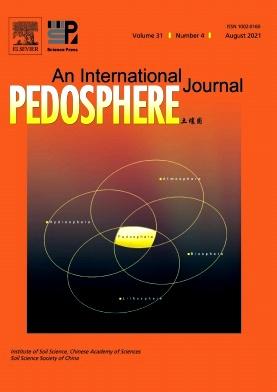不添加磷的稻鱼共生可通过调节磷组分分配和碱性磷单酯酶编码细菌群落提高稻田土壤中磷的可用性
IF 7.3
2区 农林科学
Q1 SOIL SCIENCE
引用次数: 0
摘要
稻鱼共养(RFC)对粮食安全和资源保护的贡献引起了广泛关注,但它是否能提高土壤磷素有效性并影响微生物介导的磷周转仍是一个未知的问题。在此,我们通过微观实验来评估RFC与(50 mg P kg-1作为KH2PO4)和不添加无机磷对磷组分、磷有效性和含磷细菌群落组成的影响。结果表明,不添加磷的RFC显著提高了水稻土的磷有效性和磷酸酶活性,土壤有效磷(AP)、pH和微生物量磷(MBP)对磷组分有调节作用。此外,细菌丰度与磷酸酶活性、总碳(TC)、总磷(TP)含量以及总碳(TC)与总氮(TN)、总氮与总磷(TP)之比有关。我们还发现,寄存磷细菌的关键类群有助于磷酸酶的产生和有机磷的矿化,从而提高磷的有效性。我们的研究结果表明,不添加磷的RFC有利于促进含磷细菌功能的表达,从而提高磷矿化能力。综上所述,本研究揭示了含磷细菌在加磷和不加磷条件下对磷周转的响应,揭示了农业土壤磷资源的潜在利用潜力以及磷酸酶活性对农业生态系统磷获取的贡献。本文章由计算机程序翻译,如有差异,请以英文原文为准。
Rice-fish coculture without phosphorus addition improves phosphorus availability in paddy soil by regulating phosphorus fraction partitioning and alkaline phosphomonoesterase-encoding bacterial community
Rice-fish coculture (RFC) has aroused extensive concern for its contribution to food security and resource conservation, but whether it can improve soil phosphorus (P) availability and affect microbe-mediated P turnover remains elusive. Herein, we conducted a microcosm experiment to assess the impacts of RFC combined with (50 mg P kg-1 as KH2PO4) and without inorganic P addition on P fractions, P availability, and phoD-harboring bacterial community composition. The results revealed that RFC without P addition significantly improved P availability and phosphatase activity in paddy soil, while soil available P (AP), pH, and microbial biomass P (MBP) contributed to regulating P fractions. Moreover, the phoD-harboring bacterial abundance was linked to phosphatase activity, AP, total carbon (TC), and total P (TP) contents, and the ratios of TC to total nitrogen (TN) and TN to TP. We also found that the keystone taxa of phoD-harboring bacteria contributed to phosphatase production as well as organic P mineralization, thereby improving P availability. Our findings suggest that RFC without P addition is beneficial for promoting the expression of phoD-harboring bacterial functions to improve the capacity of P mineralization. Overall, our study provides insights into the responses of phoD-harboring bacterial functions for P turnover to RFC combined with and without P addition, showing the potential utilization of P resources in agricultural soil and the contribution of phosphatase activity to P acquisition in agriculture ecosystem.
求助全文
通过发布文献求助,成功后即可免费获取论文全文。
去求助
来源期刊

Pedosphere
环境科学-土壤科学
CiteScore
11.70
自引率
1.80%
发文量
147
审稿时长
5.0 months
期刊介绍:
PEDOSPHERE—a peer-reviewed international journal published bimonthly in English—welcomes submissions from scientists around the world under a broad scope of topics relevant to timely, high quality original research findings, especially up-to-date achievements and advances in the entire field of soil science studies dealing with environmental science, ecology, agriculture, bioscience, geoscience, forestry, etc. It publishes mainly original research articles as well as some reviews, mini reviews, short communications and special issues.
 求助内容:
求助内容: 应助结果提醒方式:
应助结果提醒方式:


